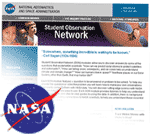
Make Sun-Earth connections as you monitor abrupt changes on the Sun when it creates solar flares and coronal mass ejections, blasting powerful "solar storms" into space. NASA satellites predict these storms in order to protect astronauts, the International Space Station, and power grids. Learn about Sun-Earth relationships and content using online NASA resources. Virtually meet NASA guest solar scientists and educators. Bring years of NASA's observations and authentic data with the story of the Sun into your classroom as an engaging context for teaching Next Generation Science Standards topics.
Course participants learn to make NASA data a central component of engaging activities that promote inquiry and science practices. Integrate math, technology, and engineering to excite students while addressing important Earth and Space science concepts. Easy access to NASA data makes tracking a solar storm easy.
| Use the unique context of solar storms and their effects on Earth to teach standards-based science and mathematics content. |
Participants attend 5 LIVE online sessions that include, but are not limited to, the following topics:
Session 1: What are Solar Storms and How are they Related to Magnetism?
Session 2: Radio Waves & the Physical Energy of the Sun
Session 3: Space Weather and the Effect on Earth's Magnetosphere
Session 4: Auroras and Telling the Solar Storm Story
Through live and asynchronous coursework, you will engage with colleagues, instructors, and experts in the field and learn how to use authentic data to drive classroom investigations. The assignments you select are directly applicable to your teaching environment and needs and are tailored to ensure success in your specific educational setting. You gain access to a carefully developed Earth-Sun comprehensive resource page with key links for the classroom integrating the elements of the course with STEM content and pedagogy.
Matter and Its Interactions
Energy
Motion and Stability: Forces and Interactions
Earth's Place in the Universe
Matter and Its Interactions
Earth's Systems
The Solar System, Remote Sensing, Atmosphere, Mapping, Radiation, Convection in the Sun, Solar Energy, Composition and Properties of Matter, Atoms and Ions, Phase Changes, Magnetic Fields, Spectroscopy, Magnetism, Sound Waves
Participants may implement course content and develop a portfolio following the guidelines of the National Board for Professional Teaching Standards, with the goal of submitting work for National Board Certification.
Educators may seek opportunities to present at conferences, or among colleagues and education community stakeholders. Course instructors and mentors will support your individual goals to become leaders in integrated STEM education.